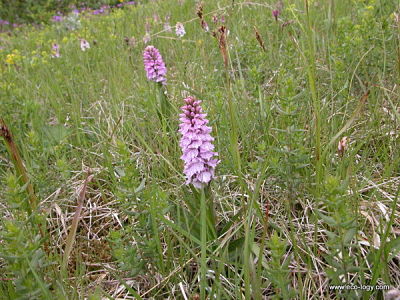The significance of beetle folivory for the growth of
Passiflora vitifolia
An initial survey showed that plants that had
received beetle herbivory were smaller, on the average,
than ungrazed plants. Beetle herbivory on mature
Passiflora vitifolia was associated with an
increased proportion of leaf loss in the early wet
season. However, a similar negative response was not
shown in the late wet season.
When responses of plants to herbivory were compared for
the experimental plants, a higher proportion of beetle
damage was associated with reduced plant growth, shown
as a lower number of leaves on individual P.
vitifolia plants.
In one experiment, where the proportion of beetle
herbivory levels was manipulated, the growth of P.
vitifolia was directly affected. Beetle herbivory on
the plants reduced their branch extension, but only when
previous damage had occurred. The negative effect of
beetle herbivory was also detected as a negative change
in leaf numbers, regardless of whether the plants had
received previous damage.
There is clear evidence of reduced growth of P.
vitifolia with increased levels of beetle herbivory.
The results show positive associations between beetle
damage and net leaf loss, a measure of the balance
between leaf formation and leaf abscission. This suggest
that beetle damage may cause leaf loss to P.
vitifolia. The correlation between beetle herbivory
and leaf loss in the early season is an indication that
beetle herbivory could be causing leaf abscission.
The beetles only cause partial damage to the leaves,
but this could result in physiological stress or
chemical changes in the leaves. Surprisingly, little
difference was found between plant responses in the
contrasting experimental habitats. However, the greater
impact of herbivory during the sunnier, early half of
the rainy season indicates that seasonal differences in
light levels could affect plant responses to damage.
The seasonally greater impact of beetle herbivory in the
early as opposed to the late season is not directly
related to higher levels of herbivory at that time.
However, it may be partly explained by a relatively
greater impact of physical factors in the late as
opposed to the early wet season. Seasonal differences
could be an indicator of the importance of internal
resources for the responses of P. vitifolia to
herbivory. After a long dry season, the plants may have
inadequate stored reserves to recover after herbivory
and this may result in reduced growth or leaf loss.
Seasonal fluctuation in resources are likely affecting
the response of P. vitifolia to damage.
Plants growing in natural habitats and at the
experimental site showed an identical pattern. Both
groups showed reduced growth in response to natural
levels of beetle herbivory. Plants growing in the forest
were much larger than the experimental plants. The
similar responses of large and small plants indicate
that large and small plants may have the same basic
mechanism in their response to herbivory. The size or
age of Passiflora may be correlated with plant
quality as food for herbivores or herbivore apparency to
predators.
There is evidence from the present study that previous
damage causes the plants to be more susceptible to later
damage. This conclusion indicates that herbivory acts as
a physiological stress factor on the plants. It is
concluded that beetle herbivory is important for the
growth of P. vitifolia in the tropical lowland
rainforest.
Author: Soffia Arnthorsdottir
Contact the author:



Fáðu nýjustu fréttir og tilboð frá Þund!
Get updates and special offers from Thund!
